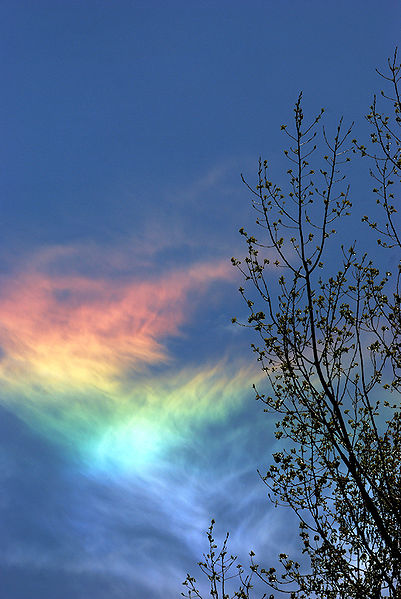No, they aren’t really rainbows, and they have nothing to do with fires. But they sure are beautiful, and photos of them have been making the rounds on the internet recently. “Fire rainbows” are technically known as circumhorizontal arcs which occur when the sun is higher than 58° above the horizon and its light passes through high-altitude cirrus clouds made up of hexagonal plate ice crystals. When optimally aligned, the ice crystals act as a prism, and the resulting refraction is reminiscent of a rainbow.
“The complete halo is a huge and beautiful multi-colored band running parallel to the horizon with its center beneath the sun. The distance below the sun is twice as far as the common 22-degree halo. Red is the uppermost color. Often, when the halo forming cloud is small or patchy, only fragments of the arc are seen. There is a myth that the halo is rare. How often it is seen depends on location and in particular latitude. In the United States it is a relatively common halo seen several times each summer in any one place. In contrast, it is rare in mid-latitude and northern Europe.
For the halo to form, the sun must be very high in the sky, at an elevation of 58° or more. Cirrus cloud or haze containing relatively large plate-shaped ice crystals must also be present. The sun altitude requirement has the consequence that the halo is impossible to see at locations north of 55°N or south of 55°S (although a lunar circumhorizontal arc might be visible). In other latitudes, it is visible for a greater or lesser time around the summer solstice. Slots of visibility for different latitudes and locations can be looked up on graphs. For example, in London, England the sun is only high enough for 140 hours between mid May and late July. Contrast that with Los Angeles with the sun higher than 58 degrees for 670 hours between late March and late September. When the cloudiness of Europe is also taken into account, the halo becomes more than 10-20X more likely to be seen in the United States” (http://en.wikipedia.org/wiki/Circumhorizontal_arc). For more on such optical effects in air, water, and ice, see http://www.dewbow.co.uk/index.html.




